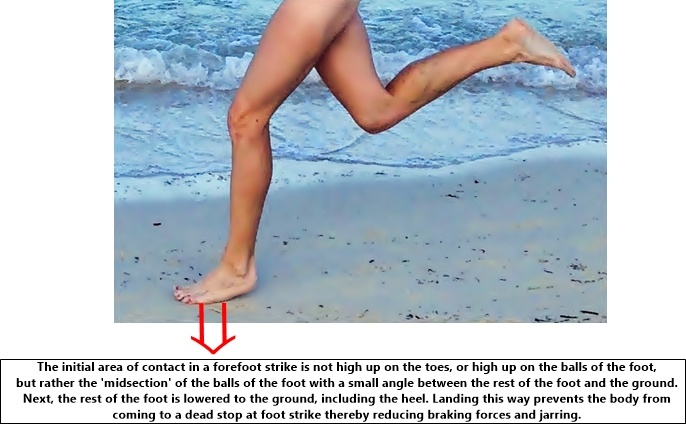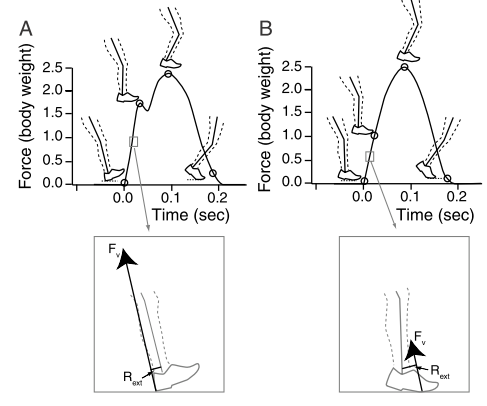There’s a long-standing belief that running on harder surfaces is harmful and that running on softer surfaces is much better for injury prevention. However, there’s firm evidence to the contrary of this. In fact, running barefoot on the hardest surface was found to be the safest way to run because it resulted in the lightest, softest footsteps as compared with running in thick cushioned running shoes.
To make it more fully understood why a barefoot runner can run completely safe on harder surfaces without producing greater impact is all thanks to the forefoot strike. Barefoot runners land with a forefoot strike which eliminates an incredibly damaging impact force known as the ‘impact transient’, which is a large burst in collisional impact only produced in heel strike running.
It’s also evident that the movement path of the foot when forefoot striking results in a smoother motion of the foot onto the ground that produces less braking, less jolt and less opposing force, regardless of surface hardness. Most relevant, take note of the last point just mentioned: ‘regardless of surface hardness’. This always needs special emphasis because it literally means that as long as you land with a forefoot strike when running barefoot, you can run safely on the hardest of surfaces without risk of injury.
Therefore, it’s not the running surface that increases your chances of injury, it’s how the foot initially interacts with the surface that determines injury.
How do we know this? A 2012 Harvard study compared the intensity of the ground reaction force in heel strike runners and forefoot runners and found that foot strike, NOT surface type, determined the peak element of the ground reaction force. The peak element being the impact transient that was produced in a heel strike, not in a forefoot strike landing.
Below shows the figures from the study comparing the impact transient in heel striking and lack-thereof in a forefoot strike:
This figure shows how heel strike running (A), generates an impact transient compared to forefoot running (B), which does not generate an impact transient. The reason heel strike running generates the impact transient is due to the body coming to a crashing halt at landing whereby the mass of the body collides too intensively with the leg and does so for a prolonged period of time. In a forefoot strike, the impact transient is completely eliminated because at landing, the foot is aligned much closer to under the ankle, knee and hips, which is the gateway strategy to effectively reduce braking to such an extent where the impact transient is fully prevented. Furthermore, forefoot striking also engages greater knee bend (more knee flexion) at landing. This enables the knee-joint to be more compliant, allowing for an even softer landing, regardless of surface hardness.
The Harvard study concluded that since forefoot running reduces all-around impact levels while eliminating peak force production, cushioned shoes are not needed for impact protection, even on hard surfaces, such as a steel plate!
Evolution Designed Humans to Run Safely Without Shoes!
Since the impact transient is eliminated in a forefoot strike, forefoot runners tend to land lightly and gently as other mammals who also do not generate ground reaction forces during running -mammals don’t ‘heel strike’ when they run, just watch your dog or cat run to see, they land on the more anterior part of the foot, or paw, hoof, etc.
The Take Home Message
These findings imply that running on harder surfaces, such as the road, is not always the main culprit in causing injury, rather it’s foot strike pattern because how your foot strikes the ground when you run determines the type of impact produced which in turn determines injury. Heel strike running produces a specific set of forces that are most directly involved in causing pretty much all injuries known to running whereas forefoot running does not, and the importance of this should always be impressed upon!
In that regard, here’s more overwhelming evidence on the long-list of impressive benefits of barefoot running.
If you’ve enjoyed my post on barefoot running, you’ll love my YouTube channel, here, where I talk more about barefoot running vs shod running as well as heel strike vs forefoot strike running.
References:
Bobbert, M. F., Schamhardt, H. C. & Nigg, B. M. Calculation of vertical ground reaction force estimates during running from positional data. J. Biomech 1991; 24, 1095–1105.
Lieberman et al. Foot strike patterns and collision forces in habitually barefoot versus shod runners. Nature 2009; 463, 531-535.
Bretta Riches
BSc Neurobiology; MSc Biomechanics candidate, ultra minimalist runner & founder of RunForefoot. I was a heel striker, always injured. I was inspired by the great Tirunesh Dibaba to try forefoot running. Now, I'm injury free. This is why I launched Run Forefoot, to advocate the health & performance benefits of forefoot running and to raise awareness on the dangers of heel striking, because the world needs to know.
Latest posts by Bretta Riches (see all)
- Can You Run In Barefoot Shoes? Yes, But DON’T Heel Strike! - 21/07/2024
- Why Cushioned Running Shoes Are Really Bad for Your Feet - 19/07/2024
- Do Cushioned Running Shoes Cause Injuries? - 17/07/2024



